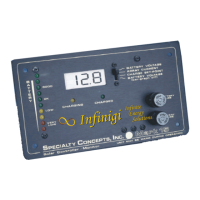The operation of the MARK/(15,20) is completely automatic. This controller will regulate the
charging of batteries during conditions of heavy usage, or when left unattended for long periods
of time. During operation, it is normal for the front plate to feel warm.
CHARGING METHOD: Low Frequency Pulse Width Modulation: - The MARK/(15,20)
provides pulses of charging current at varying durations to maintain the batteries at a full state
of charge and insure the long-term health on the batteries. The “on” and “off” cycle time is
wide enough to eliminate electronic noise and short enough to insure the batteries are always
topped off. This method allows the batteries to reach a higher voltage with the “on” cycle and
protect the batteries from gassing in the “off” cycle. This will provide the benefits of the higher
voltage (reduced sulfation and stirred up electrolyte) and prevent excessive gassing and
excessive water loss.
A TYPICAL DAY: A typical daily cycle will be as follows. As the charging starts for the day and
battery state of charge is low, charging will be continuous and the “CHARGING” light will be
on all the time. As the battery charges up, current will pass into the battery for a while and
eventually stop. Later, charging will resume and the system will continue this cycle throughout
the day. During the course of the day, the duration of the charging period of each cycle will
get shorter (cycling on for shorter periods and staying off longer). When the battery is close to
full charge, it will pulse current into the battery to achieve and maintain full charge. The
“CHARGING” light occasionally turning on and off indicates this pulse charging.
ARRAY AND BATTERY FUSES
ARRAY FUSE – An array fuse is included on the MARK/(15,20). It will protect the controller from
over-current from the solar panels, battery short circuit and incorrect wiring problems with the
system. If the fuse continued to blow after all external problems have been corrected, then
this may indicate a defective unit.
Fuse type: MARK/15: 20 Amp AGC, MARK/20: 25 amp AGC
BATTERY FUSE - A battery fuse is included on the MARK/(15,20). This will protect the controller
from over-current from the solar panels, reverse polarity from the batteries and a battery short
circuit and incorrect wiring problem in the system. If the fuse continued to blow after all
external problems have been corrected, then this may indicate a defective unit.
Fuse type: MARK/15: 20 Amp AGC, MARK/20: 25 amp AGC.
MAINTENANCE
AVOID DISCONNECTING BATTERY: Do not leave the battery disconnected from the
MARK/(15,20) for an extended period of time (weeks or months). If you need to, then
disconnect both battery and array.
RECOMMENDED ANNUAL CARE: Any solar system, when designed correctly, should provide
years of reliable charging with very little user involvement. To assure system reliability, an
annual routine of checking the electrical connections is recommended. Especially on a
moving vehicle exposed to road vibrations. Over time, electrical connections can deteriorate
or corrode causing a voltage drop and possible hot-spots at the problem area.
WHAT TO CHECK: Check to confirm all wire connections are sound and free from corrosion.
Tighten terminal block screws, inspect any fuse connections in-line, the array connections and
battery terminals. Also, consider checking for a voltage drop. See INSTALLATION
INSTRUCTIONS, step #17: CHECK FOR VOLTAGE DROP ( Page 8).
10

